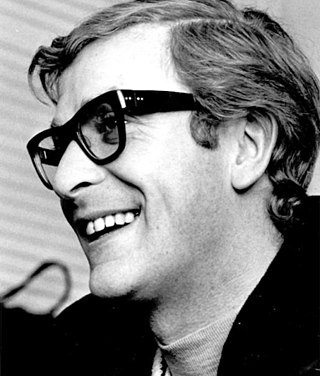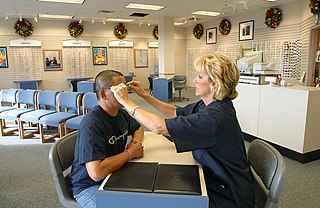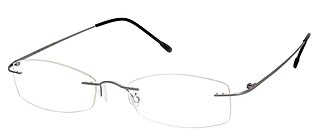
Harry Palmer is the name given to the anti-hero protagonist of several films based on spy novels written by Len Deighton, in which the main character is an unnamed intelligence officer. For convenience, the novels are also often referred to as the "Harry Palmer" novels.

A corrective lens is a transmissive optical device that is worn on the eye to improve visual perception. The most common use is to treat refractive errors: myopia, hypermetropia, astigmatism, and presbyopia. Glasses or "spectacles" are worn on the face a short distance in front of the eye. Contact lenses are worn directly on the surface of the eye. Intraocular lenses are surgically implanted most commonly after cataract removal but can be used for purely refractive purposes.

Glasses, also known as eyeglasses and spectacles, are vision eyewear with clear or tinted lenses mounted in a frame that holds them in front of a person's eyes, typically utilizing a bridge over the nose and hinged arms, known as temples or temple pieces, that rest over the ears.

Sunglasses or sun glasses are a form of protective eyewear designed primarily to prevent bright sunlight and high-energy visible light from damaging or discomforting the eyes. They can sometimes also function as a visual aid, as variously termed spectacles or glasses exist, featuring lenses that are colored, polarized or darkened. In the early 20th century, they were also known as sun cheaters.

Pince-nez is a style of glasses, popular in the late 19th and early 20th centuries, that are supported without earpieces, by pinching the bridge of the nose. The name comes from French pincer, "to pinch", and nez, "nose".

Ray-Ban is a brand of luxury sunglasses and eyeglasses created in 1936 by Bausch & Lomb. The brand is best known for its Wayfarer and Aviator lines of sunglasses. In 1999, Bausch & Lomb sold the brand to Italian eyewear conglomerate Luxottica Group for a reported $640 million.

An optician is an individual who fits eyeglasses or contact lenses by filling a refractive prescription from an optometrist or ophthalmologist. They are able to translate and adapt ophthalmic prescriptions, dispense products, and work with accessories. There are several specialties within the field.

John Jacob Bausch was a German-American maker of optical instruments who co-founded Bausch & Lomb. Over six decades he transformed his small, local optical shop into a large-scale international enterprise, pioneering the American optical industry.
"The Glasses" is the third episode of the fifth season of the American sitcom Seinfeld. The 67th episode of the series overall, it was written by the writing team Tom Gammill and Max Pross, their debut for the series, and directed by Tom Cherones. It first aired on NBC on September 30, 1993.

Ray-Ban Wayfarer sunglasses and eyeglasses have been manufactured by Ray-Ban since 1952. Made popular in the 1950s and 1960s by music and film icons such as Buddy Holly, Roy Orbison and James Dean, Wayfarers almost became discontinued in the 1970s, before a major resurgence was created in the 1980s through massive product placements.

Eyewear is a term used to refer to all devices worn over both of a person's eyes, or occasionally a single eye, for one or more of a variety of purposes. Though historically used for vision improvement and correction, eyewear has also evolved into eye protection, for fashion and aesthetic purposes, and starting in the late 20th century, computers and virtual reality.

GI glasses are eyeglasses issued by the American military to its service members. Dysphemisms for them include the most common "birth control glasses" (BCGs) and other variants. At one time, they were officially designated as regulation prescription glasses (RPGs). This was commonly said to mean "rape prevention glasses" due to their unstylish appearance. At times in the US Navy they were called to "Standard Navy Ugly Glasses" (SNUGs). Similar glasses can be issued to inmates in state and federal prisons.

Browline glasses are a style of eyeglass frames where the "bold" upper part holding the lenses resembles eyebrows framing the eyes. They were very popular during the 1950s and 1960s, especially in the United States of America. The glasses were first manufactured by Shuron Ltd in 1947 under the "Ronsir" brand, and quickly emulated by various other manufacturers. The design became the most common style of eyeglasses throughout the 1950s and the early 1960s before it was surpassed in popularity by solid plastic styles. Browlines enjoyed a renaissance as sunglasses in the 1980s before returning to popularity in the 2010s, with the rise of retro style and the hipster subculture.

Cat eye glasses are a shape of eyewear. The form is closely related to the browline style, differentiated by having an upsweep at the outer edges where the temples or arms join the frame front. Cat-eye glasses were popular in the 1950s and 1960s among women and are often associated with the Beehive hairstyle and other looks of the period. They preceded the large bug-eye glasses of the 1970s, 1980s, and 1990s.

Bug-eye glasses are a form of eyewear. They were popular in the 1970s, 1980s and 1990s, and were used for regular glasses and sunglasses. They first became popular in the mid-1970s, and succeeded the cat eye glasses of the 1950s and 1960s.
Tannereye Ltd was a Canadian sunglasses manufacturing company, specializing in leather covered sunglasses. It was established in 1978 by Peter and Maureen Leunes on Prince Edward Island.

Rimless eyeglasses are a type of eyeglasses in which the lenses are mounted directly to the bridge or temples. The style is divided into two subtypes: three-piece glasses are composed of lenses mounted to a bridge and two separate temple arms, while rimways feature a supporting arch that connects the temples to the bridge and provides extra stability for the lenses.

Lensless glasses are glasses that lack lenses. They are worn solely for aesthetic or fashion purposes, having no function in vision correction or eye protection. The frames are usually oversized, and commonly all black in color. They may be worn in conjunction with contact lenses. Advantages of lensless glasses are that they do not fog or reflect, and there is no lens that will touch long eyelashes and eyelash extensions.
Zenni Optical is an American online retailer of prescription glasses and sunglasses. Founded in 2003 by Tibor Laczay and Julia Zhen, it is based in Novato, California.

Windsor glasses are a type of eyeglasses characterised by circular or nearly circular eyerims and a thin metal frame. The style emerged in the 19th century and first became popular in the 1880s. Traditionally the bridge of Windsor glasses is a "saddle", and hence to prevent the glasses slipping off the face the temples are "riding bow temples" ; however, in a modern and extended definition, Windsors typically have a bridge with nose pads and gently curved temples.


















